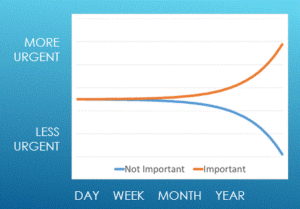Using the Eisenhower Matrix – Urgent vs. Important
As a follow up to a previous post on time stealers, I thought I would do a more detailed post on urgent and important.
Things that are urgent are attempting to get our attention. Whether we give them our attention is a crucial choice. As knowledge workers, our attention is our valuable creative resource. If we unintentionally fritter it away on unimportant tasks (whether urgent or not), we are wasting that resource.
Once we see the difference between urgent and important, we intuitively understand that we should put our attention on the important tasks and information. If an item is not urgent and not important, we know we should stop doing it, or ignore it. It is not demanding our attention (not urgent) and does not produce progress toward our goals (not important). So quadrant IV (Q-IV from the Eisenhower Matrix) items are easy to eliminate, as long as we have identified what is important.
Important is a particularly personal decision. If an item helps us make progress toward our goals, it is important. But since the goals are ours, we don’t really need anyone’s agreement on this and few people can change the level of importance without our agreement. So if you think an item is truly important, go to work on it.
Urgent is different in that the level of urgency can be manipulated by people other than you. Salespeople and advertisers make a very good living using urgency to get our attention. Anyone anywhere in the world can put something into your email inbox or ring your phone. Junk mail is often marked “Urgent!” Your boss can make something urgent pretty quickly.
The tricky part of focusing on the important is identifying those items that are urgent and not important. This decision takes your attention, although sometimes not much. We can manage many of the items in this quadrant with tools and delegation. In years past, executives had assistants whose job, in part, was to assess urgent items for importance. Now we have spam filters and unsubscribe buttons. Work to allow urgent and not important items to identify themselves so you never have to see them, or can identify them quickly.
So, having eliminated the non-important, how should you allocate your attention? Q-I or Q-II (from the Eisenhower Matrix)? In order to understand that, we need to understand how urgency works over time.

As you can see in the picture above, I argue that important items get more urgent with time, while not important items get less urgent. This means that Q-II items move to Q-I over time, while Q-III items move to Q-IV. Some people use this fact intentionally – I am aware of individuals who never respond to the first request for information or effort, but let some time pass. “If it is important, they’ll call me back,” thus letting “them” determine the urgency. Nevertheless, I suggest that these people are causing themselves a problem in that no one does their best work when the task is urgent. Deadlines cause us to cut corners. In fact, my new definition of panic is “doing things you know you shouldn’t do, due to time pressure.”
Therefore, working on Q-II items has two benefits: you have time to do better work, and fewer items get into Q-I. Therefore, over time, you gain ground on the pile of Q-I items. You can’t eliminate them completely; other people can and do wait until something is urgent before they make you aware of it. However, you can make a significant dent reasonably quickly.
The bottom line is: identify what is important so you can categorize items according to their quadrant. Then take time from Q-IV to address Q-II items and build defenses and processes to handle or identify Q-III items. Then, use the combined savings from Q-III and Q-IV to address even more Q-II items. Then utilize the additional time from fewer Q-I items to continue to address Q-II items.
Question: How much time are you able to spend in the important, but not urgent quadrant?

1 comments